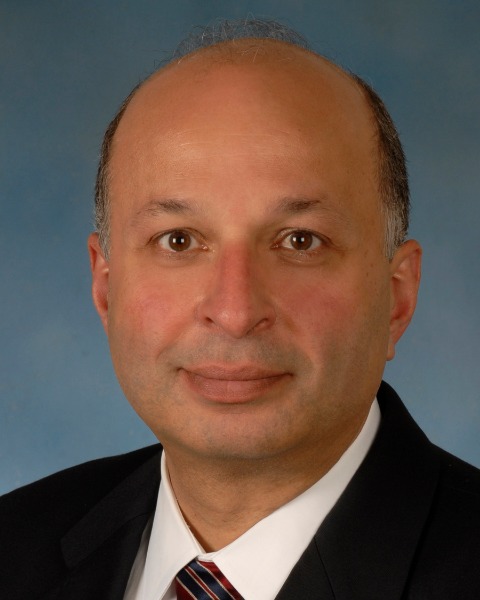Oral Abstract Session
OA – 45: Subcutaneous Daratumumab Plus Lenalidomide Versus Lenalidomide Alone as Maintenance Therapy in Newly Diagnosed Multiple Myeloma After Transplant: Primary Results from the Phase 3 AURIGA Study
Friday, September 27, 2024
3:16 PM - 3:36 PM East Coast USA Time
Location: Plenary Hall, Pavilion 3

Ashraf Z. Badros, MD
Professor of Medicine
The University of Maryland Marlene and Stewart Greenebaum Comprehensive Cancer Center, University of Maryland Medical Center, Baltimore, MD, USA
Baltimore, Maryland, United States
Speaker(s)
Introduction: Induction/consolidation (ind/con) with autologous stem cell transplant (ASCT) and lenalidomide (R) maintenance (maint) is standard of care (SoC) for transplant-eligible (TE) patients (pts) with newly diagnosed multiple myeloma (NDMM). Daratumumab (DARA) is a human anti-CD38 monoclonal antibody approved for ind/con treatment of TE NDMM. To date, no randomized trials have directly compared DARA-based therapy to SoC R maint therapy. Here we present the primary results of the phase 3 AURIGA study (NCT03901963) evaluating the addition of DARA to R maint in TE NDMM pts who were anti-CD38 naïve and positive (pos) for minimal residual disease (MRD) following ASCT after SoC ind/con.
Methods: Eligible pts with NDMM were aged 18-79 yrs, in ≥VGPR and MRD pos (10–5; NGS) following ASCT, anti-CD38 naïve, received ≥4 ind cycles, and enrolled within 12 mos of start of ind therapy and 6 mos of ASCT. Pts were stratified by cytogenetic risk and randomized 1:1 to receive 28-day cycles of R maint (10mg PO D1-28 [after C3, 15mg PO, if tolerated]) ± subcutaneous DARA (DARA SC; 1,800mg QW C1-2, Q2W C3-6, Q4W C7+) for ≤36 cycles or until disease progression, unacceptable toxicity, or withdrawal. The primary endpoint was MRD-negative (neg) conversion rate (10–5) by 12 mos from start of maint therapy.
Results: 200 pts were randomized (D-R, n=99; R, n=101). Demographic characteristics were well balanced between arms: median age (yrs) was 63 for D-R and 62 for R, and 25.3% and 23.5% of pts had ISS stage III disease. At diagnosis, 23.9% of D-R and 16.9% of R pts had high cytogenetic risk (del17p/t[4;14]/t[14;16]). Pts received a median of 5 (range, 4-8) ind cycles in both groups prior to study entry. The MRD-neg (10–5) conversion rate by 12 mos (primary endpoint) was 50.5% for D-R and 18.8% for R (odds ratio [OR], 4.51; 95% CI, 2.37-8.57; P < 0.0001) with a consistent benefit favoring D-R across all relevant subgroups. At median follow-up (32.3 mos), overall MRD-neg (10−5) rate was 60.6% for D-R and 27.7% for R. Complete response or better rate favored D-R (75.8% vs 61.4%; OR, 2.00; 95% CI, 1.08-3.69; P=0.0255). PFS favored D-R (HR, 0.53; 95% CI, 0.29-0.97); estimated 30-mo PFS rate was 82.7% for D-R and 66.4% for R.
D-R and R pts received a median of 33 and 21.5 maint cycles, respectively; 88.5% and 78.6% completed 12 cycles. Grade 3/4 treatment-emergent adverse events (TEAEs) occurred in 74.0% of D-R and 67.3% of R pts; infections (18.8% and 13.3%) and neutropenia (46.9% and 41.8%) were most common. Serious TEAEs occurred in 30.2% of D-R and 22.4% of R pts, and fatal TEAEs in 2.1% and 1.0%.
Conclusions: The addition of DARA to R maint in TE NDMM pts who were MRD pos and anti-CD38 naïve post-ASCT resulted in a significantly higher conversion rate to MRD neg by 12 mos of maint treatment than with R alone. PFS data are immature but favor D-R. No new safety signals were observed. These results demonstrate the benefit of adding DARA to R maint therapy.
Methods: Eligible pts with NDMM were aged 18-79 yrs, in ≥VGPR and MRD pos (10–5; NGS) following ASCT, anti-CD38 naïve, received ≥4 ind cycles, and enrolled within 12 mos of start of ind therapy and 6 mos of ASCT. Pts were stratified by cytogenetic risk and randomized 1:1 to receive 28-day cycles of R maint (10mg PO D1-28 [after C3, 15mg PO, if tolerated]) ± subcutaneous DARA (DARA SC; 1,800mg QW C1-2, Q2W C3-6, Q4W C7+) for ≤36 cycles or until disease progression, unacceptable toxicity, or withdrawal. The primary endpoint was MRD-negative (neg) conversion rate (10–5) by 12 mos from start of maint therapy.
Results: 200 pts were randomized (D-R, n=99; R, n=101). Demographic characteristics were well balanced between arms: median age (yrs) was 63 for D-R and 62 for R, and 25.3% and 23.5% of pts had ISS stage III disease. At diagnosis, 23.9% of D-R and 16.9% of R pts had high cytogenetic risk (del17p/t[4;14]/t[14;16]). Pts received a median of 5 (range, 4-8) ind cycles in both groups prior to study entry. The MRD-neg (10–5) conversion rate by 12 mos (primary endpoint) was 50.5% for D-R and 18.8% for R (odds ratio [OR], 4.51; 95% CI, 2.37-8.57; P < 0.0001) with a consistent benefit favoring D-R across all relevant subgroups. At median follow-up (32.3 mos), overall MRD-neg (10−5) rate was 60.6% for D-R and 27.7% for R. Complete response or better rate favored D-R (75.8% vs 61.4%; OR, 2.00; 95% CI, 1.08-3.69; P=0.0255). PFS favored D-R (HR, 0.53; 95% CI, 0.29-0.97); estimated 30-mo PFS rate was 82.7% for D-R and 66.4% for R.
D-R and R pts received a median of 33 and 21.5 maint cycles, respectively; 88.5% and 78.6% completed 12 cycles. Grade 3/4 treatment-emergent adverse events (TEAEs) occurred in 74.0% of D-R and 67.3% of R pts; infections (18.8% and 13.3%) and neutropenia (46.9% and 41.8%) were most common. Serious TEAEs occurred in 30.2% of D-R and 22.4% of R pts, and fatal TEAEs in 2.1% and 1.0%.
Conclusions: The addition of DARA to R maint in TE NDMM pts who were MRD pos and anti-CD38 naïve post-ASCT resulted in a significantly higher conversion rate to MRD neg by 12 mos of maint treatment than with R alone. PFS data are immature but favor D-R. No new safety signals were observed. These results demonstrate the benefit of adding DARA to R maint therapy.